Posted by Elena del Valle on November 30, 2011

Bone Appetite Seat, a highchair for dogs
Photo: Talin Tropic Co., Cathy Ahles
Every day since 2005 Oswaldo Cuadros, owner, Pet Sitting at Weston or one of his staff walk, play, feed, drive or just hang out with somebody else’s pets. They look after 690 animal clients, 460 dogs, 165 cats, 39 birds and 26 other types of lovable creatures. The affluent human, 98 percent white and 2 percent Hispanic between 40 and 50 years of age, clients pay his company between $7,000 and $1,000 a year, depending on their needs, to provide pet care.
These expenditures are not surprising when we take into account that 76 percent of dog/cat owners consider their pet to be part of the family, according to America’s Pet Owners US September 2011, a Mintel report. At the same time pet ownership is growing. In the past 20 years the number of American families owning a pet has increased 10 percent.
In 1998 56 percent of households owned a pet. By 2008, 72.9 million homes or 62 percent of households in America owned a pet (APPA 2011-12 National Pet Owners Survey). And, consumers are spending money on their pets.

Fancypants, a Jack Russell Terrier who was “copilot” for 13 years
This holiday season, more than half of Americans plan to spend $46 on average to buy gifts for their pets such as toys (68 percent), food (45 percent), new bedding (8 percent), clothing (6 percent), a leash, collar or harness (3 percent) or new grooming products (3 percent), according to a new AP-Petside.com poll.
The pet industry is expected to generate $50.8 billion U.S. 2011 spending, according to American Pet Products Association (APPA) figures. This year’s revenues should represent a record for the industry which has been growing steadily between 2002 and 2011. The increase in sales of pet products and services that has overcome one of the country’s worst recessions demonstrates customers strong bonds with their pets which in some cases appear to serve as surrogate family members. Mintel researchers estimate a 33 percent growth for this market segment to a high of $67.7 billion in 2016.
An example is the Bone Appetite Seat, a customized seat that allows pets 30 pounds or less to join their owners at the dinner table within their own space. The poplar product was developed by Talin Lyman, president, Talin Tropic Co. of Boca Raton, Florida.
“There is really no target age market, I get people of all ages who have pets who love the chair! I believe it is for a more high end audience, as it is a piece of art and is a higher price range. All hand made by me. I offer custom pillows and cushions out of my fabric line for the chairs. People can buy the chairs and or all of my products directly from me, My websites, and also there are a few stores who carry my products as well,” said Lyman by email in response to a question about the seat and her other pet products.
The highchairs, hand painted to the customers specifications and sometimes with their dog’s portrait, retail for $950 to $1,500. The back of the seat opens allowing the dog to climb up little steps through the rear of the chair. Custom chairs are available for larger dogs, according to the Bone Appetite Seat website. It takes two weeks for a chair to be completed plus shipping time for out of town orders.
Posted by Elena del Valle on November 29, 2011
Information provided by Event Partner

IQPC’s 4th U.S. Hispanic Marketing Summit
Miami, FL on February 27 – 29, 2012
The U.S. Hispanic Marketing Summit brings together marketing professionals to brainstorm the latest Hispanic Marketing & Advertising strategies to tap into the fastest growing demographic in the U.S.
The Latino- case for action has beome a case harder to argue against than one to embrace. So let’s restate what you’ve heard before yet one more time: According to the U.S. Census, Latinos grew by 43% from 38 Million in 2000 to 50 Million in 2010, while the Non-Hispanic population only grew by 4.9%. But more than population numbers, there is a significant financial growth represented by this group. In the last 10 years, Hispanic buying power has grown by 347% reaching $1 Trilion in 2010.
Source: “Top 5 Reasons Why Latinos Must Be on Your Agenda”
By: Lili Gil, Hispanic Market Expert, Media Contributor, and Co-Founder of XL Alliance
**Former Director of Marketing Services – Hispanic Marketing Initiative Lead of Johnson & Johnson
Early confirmed Hispanic marketing expert speakers include:
– Dawn Lee Williamson, VP of Sales & Marketing, CNN
– Adrian Fueyo, Director of Integrated Digital Marketing, NBC Universal/Telemundo
– Juan Penso, Director of Hispanic Direct Response, Comcast
– Santa Brito, Senior Manager of Consumer Marketing, ESPN Deportes
– Maribel Viteri, Regional Marketing Director of Latin America, Molson Coors
– Lili Gil, Hispanic Market Expert, Media Contributor and Co-Founder, XL Alliance
– Mike Foley, U.S. Hispanic Marketing Lead, Post Foods, LLC.
– Tatiana Hansell, Senior Multicultural Marketing Manager, Unilever
– Marc Strachan, VP of Multicultural Marketing, North America, Diageo
– Ingrid Rivera, Regional Marketing & Profitability Manager for Latin America and Caribbean, Subway
Benefits of attending:
– How to acquire buy-in to create, expand via new allocation, or re-define a dedicated Hispanic Advertising & Marketing division
– Create a culturally relevant marketing plan
– How to cater to acculturation as oppose to assimilation
– How to leverage a balance between both traditional and emerging marketing methods, market research, and segmentation
Join us on February 27-29, 2012 in Miami and be part of this unique opportunity full of roundtable discussions, networking receptions, cast studies, workshops and more! Register by January 6th and save up to $800 on the All Access Pass! Mention code: USHM_HispanicMPR for a 10% discount for Hispanic MPR members
Visit www.USHispanicMarketingSummit.com for more information
About IQPC
IQPC (www.iqpc.com) provides business executives with tailored practical conferences, large-scale events, topical seminars and in-house training programs. Producing over 1,500 events annually around the world, IQPC continues to grow and has offices in cities across six continents including: Berlin, Dubai, London, New York, Sao Paulo, Singapore, Sydney, and Toronto.
Posted by Elena del Valle on November 28, 2011

Thomas Cooper, Ph.D., author, Fast Media Media Fast
Photo: Thomas Cooper, Ph.D.
A podcast interview with Thomas Cooper, Ph.D., author, Fast Media Media Fast (see Massachusetts professor addresses media overload), is available in the Podcast Section of Hispanic Marketing & Public Relations, HispanicMPR.com. During the podcast, he discusses media responsibility with Elena del Valle, host of the HispanicMPR.com podcast.
Tom is a professor of Visual and Media Arts at Boston’s Emerson College. He previously taught at Harvard University and the University of Hawaii. A former assistant to Marshall McLuhan, he is the co-founder and co-publisher of Media Ethics magazine. He serves as speechwriter for Jochen Zeitz who is chief executive officer of Puma.
To listen to the interview, scroll down until you see “Podcast” on the right hand side, then select “HMPR Thomas Cooper, Ph.D.” click on the play button below or download the MP3 file to your iPod or MP3 player to listen on the go, in your car or at home. To download it, click on the arrow of the recording you wish to copy and save it to disk. The podcast will remain listed in the November 2011 section of the podcast archive.
Posted by Elena del Valle on November 18, 2011
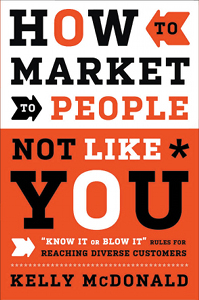
How to Market to People Not Like You book cover
Photos: Wiley
Many marketers believe that for effective marketing it is important, if not essential, to have a clear idea of who the target audience is. The thinking is that knowing who you are addressing as well as his or her likes and dislikes allows you to craft a message that resonates with the end user, listener, reader or buyer and make the message available in a channel convenient to him or her.
Kelly McDonald, an ad executive who counts among her skills multicultural marketing, takes the idea a step further. She proposes Narrowcasting, a way to reach out to a highly targeted group in an optimum fashion. In her opinion it’s better to reach a sliver of the market that has an interest in your product or service effectively than to reach a broad spectrum of the population with no interest in what you represent. She explains her ideas and how to implement them in How to Market to People Not Like You “Know It or Blow It” Rules for Reaching Diverse Customers (Wiley, $24.95), a 209-page hardcover book published March of this year.
Her book is divided into three distinct sections: Seven Steps for Selling to New and Unfamiliar Customers, Key Customers Who Could Drive Your Business Growth, and Other Important Market Segments. She starts out addressing the concept that there are likely desirable customers the reader has not thought of and ways to capture them as customers.
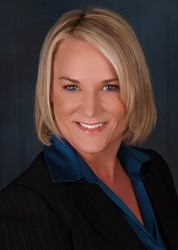
Kelly Mcdonald, author, How to Market to People Not Like You
In the second section, she discusses specific groups such as different generations, women, immigrants, Hispanics, African-Americans, and Asians and Asian-Americans. In the final section, she explores groups by political views, sexuality, hobbies and special interests, urban versus rural residents, military versus civilian markets and vegetarian versus meat eaters.
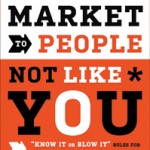
Click to buy How to Market to People Not Like You
Comments:
Filed Under: Books
Posted by Elena del Valle on November 16, 2011

Le Wang, assistant professor, economics, University of New Hampshire
Photo: University of New Hampshire
Marketers targeting Hispanic immigrant men take note. A change in immigration policies after September 11 at federal and state levels and heightened immigration enforcement efforts may have changed the living conditions of Hispanic immigrants and increased their incentives to marry natives. A recent study indicates Hispanic immigrants, men specifically, have become more likely to marry natives post 9/11 than before that date.
According to the study, marriages between Hispanic immigrants and natives increased by more than 2 percent in the decade following the attacks of September 11. In the first two years after 9/11 there was a small increase in marriages to natives while in the years after that the increase became yet more noticeable.
These marriages helped offset the deterioration in job prospects for Hispanic immigrants that resulted from discrimination following the attacks, according to new research from the University of New Hampshire.
“Being married to a native increases employment rates by 1.2 percent and earnings by 21.8 percent,” according to researchers at the University of New Hampshire and the University of Massachusetts at Dartmouth. “The offsetting effect may not be particularly large, given the estimated effect of Sept. 11 on intermarriage being about 2 percent. Nevertheless, this result highlights the possible importance of the labor market incentives that are associated with the increased rates of intermarriage among Hispanics.”
The researchers believe their results reflect the actions of undocumented immigrants, Hispanic immigrants marrying Hispanic natives, immigrants who were married before arrival, or new immigrants; and call for further research to better understand the intermarriage behaviors of Hispanics.
An article about the research titled The effects of 9/11 on intermarriage between natives and immigrants to the U.S. was published September 2011 in the Review of Economics of the Household and was the work of Le Wang, assistant professor, economics, University of New Hampshire, and Chunbei Wang, assistant professor, economics, University of Massachusetts at Dartmouth. The researchers analyzed the March Current Population Survey 1995-2010 and relied on a difference-in-differences approach to estimate the impact of 9/11 on intermarriage among Hispanic immigrants.
Posted by Elena del Valle on November 14, 2011

World No Tobacco campaign ad
Photos: vi.sualize.us, Campaign for Tobacco-Free Kids
Some 400,000 people die each year from their own cigarette smoking and another 50,000 adult nonsmokers die each year from exposure to secondhand smoke; there are six million children under 18 alive today who may eventually die from smoking; and 8.6 million people in the United States currently suffer from smoking-caused illness, according to the Campaign for Tobacco-Free Kids, a Washington, D.C. based nonprofit advocacy organization that strives to save lives by advocating for public policies that prevent kids from smoking.”
Many young Americans, whites and Hispanics may be opposed to smoking. More than half of respondents to a national telephone survey of 1,110 registered voters conducted October 23, 2011 disapproved of people who smoke; 52 percent of respondents asked whether they frown on people who smoke said yes, 31 percent said they did not and 17 percent had no opinion. Young survey participants, in the 18-29 year old age group, were the most likely, at 63 percent, to say they frown on smokers.
Although 54 percent of white respondents and 48 percent of Hispanic respondents said they disliked smokers, 51 percent of African-Americans said they do not frown on people who smoke. Among women respondents 53.2 percent said they frowned on smokers compared to 50.5 percent of men who said they frowned on smokers.
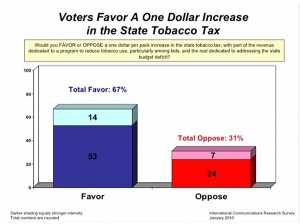
Two-thirds of voters polled supported increasing the state tobacco tax – click to enlarge
Curiously political orientation had little influence on opinions about smokers among respondents of that survey. The difference between Republicans, 54 percent, and Democrats, 53 percent, not happy with smokers was only 1 percent while fewer Independents, 48 percent, said they frowned on smokers. The survey was conducted and paid for by Poll Position, a non-partisan news, polling, and social media company.
A January 2010 national telephone survey of 847 registered voters conducted through an International Communications Research Excel study indicated that two-thirds of voters polled supported increasing the state tobacco tax by $1.00 per pack.
An older national survey, from 2006, of 1,000 likely general election voters with an oversampling of black and Hispanics voters found Hispanics to be the most supportive of smoke-free laws. In the Mellman Group survey 69 percent of respondents said they favored smoke-free laws; 69 percent of whites, 65 percent of blacks and 78 percent of Hispanics favored such laws. More women, 74 percent, than men, 64 percent, more Democrats, 73 percent, than Republicans, 67 percent, favored the smoke-free laws.
Posted by Elena del Valle on November 11, 2011

Aim High book cover
Photos: Laura Contreras-Rowe
After finding financial and career success in real estate and happiness in her personal life Laura Contreras-Rowe, a realtor and business owner from Virginia, looked around and asked herself what she might do to bring attention to successful women like her across the country. She dedicated her energy, enthusiasm, entrepreneurial spirit and $50,000 to a book project.
Ten months later, in 2009, she held the result of her efforts, 3,500 copies of Aim High Extraordinary Stories of Hispanic and Latina Women ($27.95), a 153-page hard cover self published book in which she profiles 33 Latina women of her choosing. As of this writing 3,000 copies are gone and a new printing of the book is due January 2012.
Featuring Bible quotes the book profiles women in varied walks of like. Each profile includes a biography and color photos taken by Contreras-Rowe during meetings with the women.
The profiles are of women in a number of professions such as orientation and mobility specialist, network business how host, basketball coach, former treasurer of the United States, executive at a technology company, executive director of a non profit for boys and girls, artist, chef and catering company owner, executive director of a non profit children’s home, life coach and speaker, actor, school psychologist, drag racer, program manager at a girl’s non profit, and writer educator and performance artist; as well as deputy manager at a government space program, photographer, graduate student, registered nurse, author, retired school principal and business owner, dentist, dean at a university, publisher, police sergeant, dance teacher and business owner, strategist at a government intelligence agency, business founder and owner, non profit president and chief executive officer, Indy race car driver, lieutenant commander in the armed forces, and attorney.
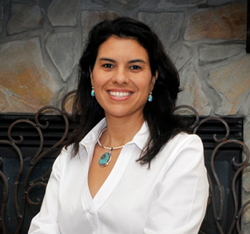
Laura Contreras-Rowe, author, Aim High
The book was recognized with the Independent Publishers Book Awards 2010 Gold First Place in Best Non-Fiction Multicultural Juvenile Youth Young Adult Book; International Latino Book Awards 2010 First Place in Best Gift Book, Second Place in Best Cover Design and Honorable Mention Third Place Mariposa Award for Best First Book; and Latino Literacy Now-2010 Book into Movie Awards and Second Place Documentary Category.

Click to buy Aim High
Comments:
Filed Under: Books
Posted by Elena del Valle on November 9, 2011

Juan Motta, head, Nestlé’s Emerging Markets
Photo: Nestlé USA
Executives at Swiss owned Nestlé want to reach Spanish dominant Hispanics in the United States with Construye el Mejor Nido (Spanish for Create the Best Nest), a new communication platform that offers Nestlé’s nutrition, health and wellness resources to Spanish speakers. The program was announced at the end of September 2011 in time to mark the year’s Hispanic Heritage Month.
According to promotional materials, elements of the program, which marks several firsts for the company, include efforts on Spanish language television, Facebook, a bilingual website, in store marketing, and product sampling packs. It is the first time the company launches an integrated multi-brand platform for consumers and shoppers in the United States; the first time Nestlé USA plans a corporate branded TV campaign; the first time Nestlé iconography of the nest concept is leveraged as a concept domestically; and the first time Nestlé USA plans to leverage its equity and drive associations between the Nestlé brand and individual brands.
The company released three television ads designed to demonstrate how Nestlé products “fit into Hispanic consumers’ everyday life and help them to nurture their family’s lives.” The ads are also designed to leverage and reinforce Nestlé’s iconography of the nest in the Nestlé corporate logo which executives hope conveys family, trust and well-being to Hispanics.
“Hispanic Heritage Month is the perfect time for Nestlé USA to reaffirm its strong history of awareness, trust and expertise among Hispanic consumers,” said Juan Motta, head, Nestlé’s Emerging Markets. “This awareness and trust stems from a strong emotional connection with authentic Nestlé brands in consumers’ home countries such as Nescafé, Abuelita, Nido and La Lechera. Construye el Mejor Nido provides consumers with information on familiar brands, as well as with other Nestlé brands available in the U.S. such as Juicy Juice and Stouffer’s.”
Believing that Facebook reaches 98 percent of Hispanic women 35 to 49 who go online Nestlé USA established Facebook.com/ElMejorNido. The page, which features contributions from Hispanic bloggers, is meant to provide a brand and cultural connection, and a place where visitors can share recipes and tips. To further its online reach the company established ElMejorNido.com, a bilingual website that promises blogger contributions, tips, articles, food videos and information on wellness, culture and parenting. The site also offers Nestlé the means to build a marketing list by providing visitors the option to receive information from the company.
Construye El Mejor Nido, an in-store effort, was designed to reach Hispanic shoppers in independent and mainstream stores through in-store circulars, bilingual door hangers, and recipe booklets. Nestlé plans to introduce new products and connect with Latino consumers by providing Fiesta Packs with new products, recipes, and party supplies to select Hispanic families. The company’s promotional materials indicate the Construye El Mejor Nido program has been well received by consumers, with traffic to the website and Facebook page exceeding expectations.
Posted by Elena del Valle on November 7, 2011

David Wachs, president, Cellit
Photos: Autotrader.com, Cellit
A podcast interview with Jose Puente, director, Mobile Strategy, AutoTrader.com, and David Wachs, president, Cellit, is available in the Podcast Section of Hispanic Marketing & Public Relations, HispanicMPR.com. During the podcast, they discuss mobile marketing with Elena del Valle, host of the HispanicMPR.com podcast.
Jose joined Autotrader.com in 2008 as general manager to develop and launch the company’s strategy for the Hispanic market. Within two years, AutoTrader Latino was ranked by comScore among the top 25 Spanish language websites in the United States. Core to driving the brand’s success Jose developed a comprehensive mobile product platform that includes a mobile website, iPhone and Android apps with voice search and augmented reality features, and an SMS platform to connect buyers and sellers.
The mobile products represent over 40 percent of all user activity, driving significant return on investment to thousands of local dealership advertisers and national brands such as Toyota, Nissan and GM. He is responsible for developing the mobile strategy for AutoTrader.com to include dealer specific products as well as consumer products.
Prior to joining AutoTrader.com, Jose was chief executive officer of Avenida America, Inc. a multimedia Spanish language communications company with products including yellow pages, auto guides, apartment guides in print, online and mobile. In 2008, he was recognized by Catalyst magazine as one of the top 10 entrepreneurs in Atlanta. He is a native of Mexico and resides in Atlanta, Georgia with his family.

Jose Puente, director, Mobile Strategy, AutoTrader.com
David is the founder of Cellit. With an engineering background, David created the Cellit platform as a solution for real estate agents to market their properties; he quickly realized that retailers and other industries could benefit from connecting to their clients through their mobile devices.
David is a dual cum laude graduate of the University of Pennsylvania’s Jerome Fisher Program in Management and Technology. He holds a B.S. in Economics from the Wharton School and a B.S.E. in Computer Science Engineering from the School of Engineering.
To listen to the interview, scroll down until you see “Podcast” on the right hand side, then select “HMPR Jose Puente, David Wachs” click on the play button below or download the MP3 file to your iPod or MP3 player to listen on the go, in your car or at home. To download it, click on the arrow of the recording you wish to copy and save it to disk. The podcast will remain listed in the November 2011 section of the podcast archive.
Posted by Elena del Valle on November 4, 2011
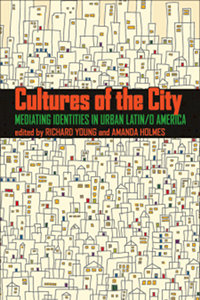
Cultures of the City book cover
Photo: University of Pittsburgh Press
Fifteen academics, eight women and seven men, address Latino identities in urban environments in Latin America and the United States in Cultures of the City Mediating Identities in Urban Latin/o American (University of Pittsburg Press, $25.95). The book was edited by Richard Young, professor emeritus of Spanish and Latin American studies, University of Alberta, and Amanda Holmes, department chair of Hispanic studies, McGill University.
The 262-page softcover book with 15 illustrations was published in 2010. It is divided into three main sections, Imagining Urban Identities, Urban Identities and Cultures on the Periphery, and Performance and the Ritualization of Urban Identities.
While most of the book addresses Latin American cities including Asuncion, Bogota, Buenos Aires, Havana, Lima, Mexico City, Recife, and Salvador two chapters discuss cities in the United States. Rodolfo D. Torres and Juan R. Buriel address Feasting on Latina/o Labor in Multicultural Los Angeles and Catherine L. Benamou addresses Mediating the Public Sphere in Latina/o Detroit: Heart and Margin of an Embattled Metropolis.
Benamou is associate professor of Film and Media Studies and Chicano/Latino Studies, University of California-Irvine. Buriel is assistant professor of English, College of the Canyons in Valencia, California. Torres is professor of Urban Planning and Political Science, University of California-Irvine.

Click to buy Cultures of the City
Comments:
Filed Under: Books




























